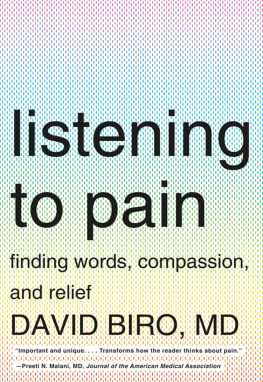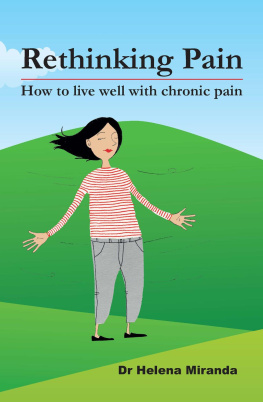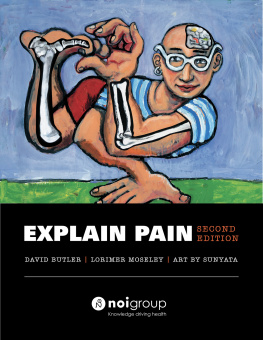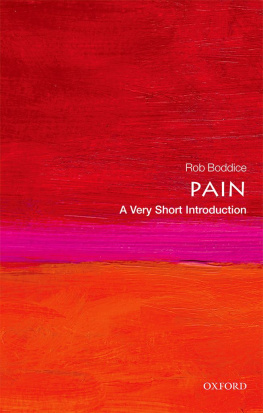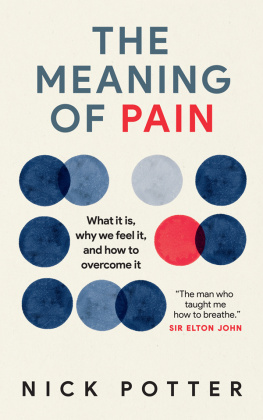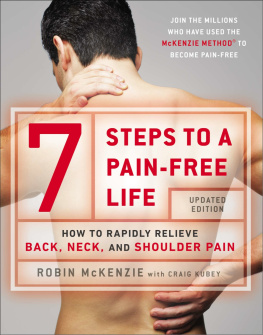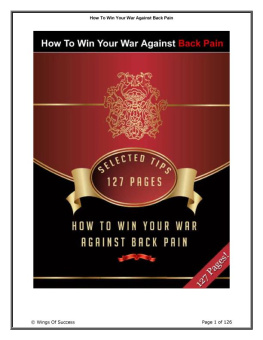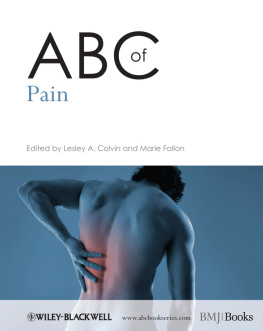LISTENING TO PAIN
Finding Words, Compassion, and Relief
DAVID BIRO, MD

W. W. NORTON & COMPANY New York London
Copyright 2010 by David Biro
Printed in the United States of America
First published as a Norton paperback 2011
All rights reserved
For information about permission to reproduce selections from this book, write to Permissions, W. W. Norton & Company, Inc., 500 Fifth Avenue, New York, NY 10110
For information about special discounts for bulk purchases, please contact W. W. Norton Special Sales at specialsales@wwnorton.com or 800-233-4830
Manufacturing by RR Donnelley, Harrisionburg, VA
Book design by JAM Design
Production manager: Andrew Marasia
Library of Congress has catalogued the hardcover edition as follows:
Biro, David, 1964
The language of pain: finding words, compassion, and relief / David Biro.1st ed.
p. cm.
Includes bibliographical references.
ISBN: 978-0-393-07063-7 (hardcover)
1. PainPhysiological aspects. 2. PainPsychological aspects.
I. Title.
RB127.B54 2010
616'.0472dc22
2009026134
ISBN 978-0-393-34025-9 pbk.
W. W. Norton & Company, Inc.
500 Fifth Avenue, New York, N.Y. 10110
www.wwnorton.com
W. W. Norton & Company Ltd.
Castle House, 75/76 Wells Street, London W1T 3QT
For Dolores and Laszlo
and
For Daniella, Luca, and Daniel
Contents
LISTENING TO PAIN
Introduction
Neoptolemus:
What is this thing that comes upon you suddenly, that makes you cry and moan so?
Philoctetes:
Terrible it is, beyond words reach. But pity me.
S OPHOCLES, Philoctetes
Pain is difficult to express. Language and pain seem as far apart as the opposite poles of an electric current. While language can capture much of the diverse range of human experience, it fails us in the case of pain. We try to find the right words, but typically come up empty. We end up wringing our hands and resigning ourselves to silence. A perfect image of the experience, as Elaine Scarry, our most provocative thinker on the subject, suggests, is Edvard Munchs painting The Scream . Munchs figure clutches the sides of his head with his hands. His mouth, open wide, is poised to vocalize his anguish. But no sound is uttered. No oneneither the boaters, nor the two figures walking away, nor viewers of the paintingcan hear the mans scream.
This is not an exaggeration. I recognized its truth early on in my medical training, while first observing the awkward interaction between patients and physicians. But it wasnt until years later, when I became a patient myself, that I truly understood Munchs terrifying vision. Shortly after finishing my residency, I was diagnosed with a rare and life-threatening blood disorder. Between the physical symptoms (an intermittent ache in one eye and increasing lethargy) and the psychological ones (anger and fear about what was happening and what might happen), I could barely think straight. During visits with the doctor, I stuttered and stammered like a bumbling fool. Still, my inarticulateness paled in comparison with what took place in the hospital during my bone marrow transplant. At its most intense, the pain literally strangled my vocal cords. Silenced, I felt just like Munchs sufferer: wanting to scream as loudly as I could but unable to make a sound.
Expressing pain seems impossible, whether the paralyzing pain from ulcers spreading through the gastrointestinal tract or the less debilitating kind caused by a blood clot in the eye. Patients, even physicians who become patients, find themselves tongue-tied. We hesitate, unsure how to beginhow to describe what feels so immediate and yet so intangible at the same time. When and if we do make the attempt, were convinced that no one else, especially the person in the white coat at the other end of the examining table, could ever understand.
The medical community is aware of the problem. Over the years it has tried to help patients articulate their pain. One of the most promising attempts was the McGill Pain Questionnaire, created in the 1970s. It provides patients with lengthy lists of descriptive words they can choose to convey their feelings. But with the exception of highly specialized pain clinics, medical practitioners rarely use the questionnaire these days. It may be too complicated to explain. It takes too much time to fill out. And perhaps, despite the good intentions of its authors, both parties remain unsatisfied: doctors are uncomfortable with the forms metaphorical language, and patients want even more of it.
Instead, health-care providers rely much more commonly on the very basic, almost primitive series of pictures known as the Faces Pain Scale:
The scale dispenses with words altogether and focuses on just one aspect of pain: its intensity. Elaine Scarry is right when she says that pain causes us to regress to a state anterior to language, to the sounds and cries a human being makes before language is learned. In fact no one even bothers to talk anymore in the clinic or emergency room. We simply point to the picture and keep our pain to ourselves.
But we mustnt think the problem is confined to the average person. Even those with a gift for language, our greatest poets and writers, have found it difficult to capture pain in words. Emily Dickinson once wrote that pain has an Element of Blank. The patients in W. H. Audens poem Surgical Ward live beneath their bandages and no longer communicate in human terms: It is not talk like ours, but groans they smother. And Virginia Woolf too, that most lyrical of prose writers, found herself at a loss for words in the summer of 1925 during a bout of influenza. So she looked to famous authors of the past to see if they had more to say about such a common part of life. Surprisingly, she found very little. Literature is concerned with the mind, she decided, not the daily dramas of the body. When it came to pain, there was a poverty of language: Let a sufferer try to describe a pain in his head and language at once runs dry.
The inexpressibility of pain, then, is our starting point. From there, this book has two main goals: to explore the reasons for this inexpressibility and to discover ways of overcoming them. Why does the language run dry, and how can we restore its flow? By answering these questions, I hope to help sufferers recover their voice and to generate a rhetoric of pain.
The consequences of silence are unacceptable. It has been estimated that one out of every five Americans suffers from chronic pain, and that staggering number does not include the many millions more who suffer from acute physical pain or psychological illnesses like depression. If we wish to relieve their painand it will be our pain too at some pointwe must first hear it. On the most practical level, the medical profession must hear it. Physicians rely on a patients storyhow well he or she is able to describe symptomsas much as they do on stethoscopes and blood tests. Studies have shown that the more detailed those descriptions are, the better physicians are at pinpointing the source of pain and administering appropriate treatment. Yet most patients tend to be about as inarticulate as I was when it comes to pain, and physicians often either are unable to coax them in the right direction or dont have enough time and patience to try. The result is that both parties quickly become frustrated and fall back on pointing at the sad faces on the chart and writing indiscriminate prescriptions. Even worse, the pain may be ignored, which happens more commonly than the medical profession would like to admit.

